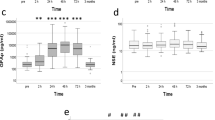Abstract
The prediction of outcome after ischemic stroke (IS) is currently based on indirect data from clinical and radiological evaluation. We evaluated the usefulness of serum Tau protein as possible prognostic markers for IS. Fifty-six patients with computed tomography-confirmed IS were enrolled. Blood samples were obtained on days 1, 3, 5, and 10 after stroke onset. Tau and S100BB serum levels were measured by commercially available enzyme-linked immunosorbent assay. Neurological deficits were quantified by the National Institute of Health Stroke Scale on days 1, 3, 5, and 10 of stroke. Functional disability was rated with the Barthel Index and Rankin Scale on days 1, 3, 5, and 10 and additionally 3 months after the stroke. Computed tomography scan was performed to calculate infarct volume on admission to hospital and on day 10 from the diagnosis of IS onset. Tau protein was detected in the serum of 47.8% patients with IS. Patients in whom Tau protein was detected in serum, when compared with patients without Tau protein, developed more severe neurological deficits, had worse functional status measured in the early and late phase of IS, and were found to have larger volume of infarction. However, Tau protein concentrations measured within the early phase of IS did not correlate with degrees of neurological deficit and disability in the early phase and also after 3 months of IS. Detection of Tau protein in the serum of patients with IS but not its concentration can be considered as a bad prognostic factor for the clinical outcome in early and late phase of IS.



Similar content being viewed by others

References
Abraha HD, Butterworth RJ, Bath PM, Wassif WS, Garthwaite J, Sherwood RA (1997) Serum S-100 protein, relationship to clinical outcome in acute stroke. Ann Clin Biochem 34:546–550
Bernacki J, Dobrowolska A, Nierwińska K, Małecki A (2008) Physiology and pharmacological role of the blood–brain barrier. Pharmacol Rep 60:600–622
Bitsch A, Horn C, Kemmling Y, Seipelt M, Hellenbrand U, Stiefel M et al (2002) Serum Tau protein level as a marker of axonal damage in acute ischemic stroke. Eur Neurol 47:45–51
Castellanos M, Serena J (2007) Applicability of biomarkers in ischemic stroke. Cerebrovasc Dis 24(Suppl 1):7–15
Fassbender K, Schmidt R, Schreiner A, Fatar M, Muhlhauser F, Daffertshofer M, Hennerici M (1997) Leakage of brain-originated proteins in peripheral blood: temporal profile and diagnostic value in early ischemic stroke. J Neurol Sci 148:101–105
Foerch C, du Mesnil de Rochemont R, Singer O, Neumann-Haefelin T, Buchkremer M, Zanella FE et al (2003) S100B as a surrogate marker for successful clot lysis in hyperacute middle cerebral artery occlusion. J Neurol Neurosur Psychiatry 74:322–325
Foerch C, Otto B, Singer OC, Neumann-Haefelin T, Yan B, Berkefeld I et al (2004) Serum S100B predicts a malignant course of infarction in patients with acute middle cerebral artery occlusion. Stroke 35:2160–2164
Foerch C, Singer OC, Neumann-Haefelin T, du Mesnil de Rochemont R, Steinmetz H, Sitzer M (2005) Evaluation of serum S100B as a surrogate marker for long-term outcome and infarct volume in acute middle cerebral artery infarction. Arch Neurol 62:1130–1134
Foerch C, Wunderlich MT, Dvorak F, Humpich M, Kahles T, Goerter M et al (2007) Elevated serum S100B levels indicate a higher risk of hemorrhagic transformation after thrombolytic therapy in acute stroke. Stroke 38:2491–2495
Jauch EC, Lindsell C, Broderick J, Fagan SC, Tilley BC, Levine SR, NINDS rt-PA Stroke Study Group (2006) Association of serial biochemical markers with acute ischemic stroke: the National Institute of Neurological Disorders and Stroke recombinant tissue plasminogen activator stroke study. Stroke 37:508–2513
Kanner AA, Marchi N, Fazio V, Mayberg MR, Koltz MT, Siomin V et al (2003) Serum S100bb: a noninvasive marker of blood–brain barrier function and brain lesions. Cancer 97:2806–2813
Kumar K (2005) Overview: use of biomarkers for early diagnosis of ischemic stroke. Curr Opin Investig Drugs 6:2–4
Laskowitz DT, Grocott H, Hsia A, Copeland KR (1998) Serum markers of cerebral ischaemia. J Stroke Cerebrovasc Dis 7:234–241
Laterza OF, Modur VR, Crimmins DL, Olander JV, Landt Y, Lee JM, Ladenson JH (2006) Identification of novel brain biomarkers. Clin Chem 52:1713–1721
Lynch JR, Blessing R, White WD, Grocott HP, Newman MF, Laskowitz DT (2004) Novel diagnostic test for acute stroke. Stroke 3:57–63
Missler U, Wiesmann M, Friedrich C, Kaps M (1997) S-100 protein and neuron- specific enolase concentrations in blood as indicators of infraction volume and prognosis in acute ischemic stroke. Stroke 28:1956–1960
Wang M, Etu J, Joshi S (2007) Enhanced disruption of the blood brain barrier by intracarotid mannitol injection during transient cerebral hypoperfusion in rabbits. J Neurosurg Anesthesiol 19:249–256
Wunderlich MT, Wallesch CW, Goertler M (2004) Release of neurobiochemical markers of brain damage is related to the neurovascular status on admission and the site of arterial occlusion in acute ischemic stroke. J Neurol Sci 227:49–53
Wunderlich MT, Lins H, Skalej M, Wallesch CW, Goertler M (2006) Neuron- specific enolase and tau protein as neurobiochemical markers of neuronal damage are related to early clinical course and long-term outcome in acute ischemic stroke. Clin Neurol Neurosurg 108:558–563
Acknowledgement
The study was partially supported by Grant No. 2POSB06230 from the Ministry of Science and Higher Education in Poland.
Author information
Authors and Affiliations
Corresponding author
Rights and permissions
About this article
Cite this article
Bielewicz, J., Kurzepa, J., Czekajska-Chehab, E. et al. Does Serum Tau Protein Predict the Outcome of Patients with Ischemic Stroke?. J Mol Neurosci 43, 241–245 (2011). https://doi.org/10.1007/s12031-010-9403-4
Received:
Accepted:
Published:
Issue Date:
DOI: https://doi.org/10.1007/s12031-010-9403-4



